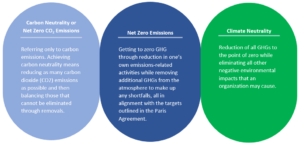Carbon Neutrality
Failing to mitigate climate change could damage corporate infrastructure, lead to business disruptions and closures and slow economic growth. Investors are increasingly demanding that corporations take action on the climate. The Climate Action 100+ investing group, represented by big-name investors like BlackRock and Pimco, with total assets of over $47 trillion, are forcing the companies they hold to drastically reduce their emissions by 2050 or sooner.
As a result of this development the number of organizations, including governments and private companies, that have announced deadlines for reaching emission reduction targets has doubled in less than a year. But how companies announce their targets can differ greatly. And the most common terms, like carbon or climate neutrality and net zero, are often used interchangeably. However, there is a difference in meaning that we need to consider.
What Is Carbon Neutrality?
According to the definition of the Intergovernmental Panel on Climate Change (IPCC), carbon neutrality, or net zero CO2 emissions, refers only to carbon dioxide emissions and is a state of balance between the CO2 emitted into the atmosphere and the CO2 removed from the atmosphere.
In actual business practice, organizations often use the term “carbon neutrality” to include all greenhouse gas (GHG) emissions when they announce their ambitious emissions reduction targets.
The Difference Between Carbon Neutrality, Net Zero & Climate Neutrality
While in practice carbon neutrality, net zero and climate neutrality are often used interchangeably, the IPCC provides a clear definition for each term. Net-zero emissions encompasses all GHG emissions, but also refers to balancing the emitted GHGs with the removed GHGs within a certain period of time. Climate neutrality, on the other hand, goes even further and considers all human impacts that affect the climate.

Source: IPCC. For detailed definitions see their Glossary of Terms.
Carbon neutrality can be differentiated from “net zero” and “climate neutrality,” because, on the surface, it technically reflects only carbon. However, in practical terms, when sustainability experts make assertions based on calculations, they often refer to all the GHGs with the term “carbon neutrality,” because they normally convert non-carbon GHGs into carbon equivalencies.
When Sphera’s sustainability experts assist a company in assessing its carbon footprint, we always include all GHGs, which are then converted into CO2 equivalents in line with all relevant standards. We believe that no responsible sustainability consultancy would ever only include carbon dioxide when conducting assessments in relationship with carbon neutrality. That’s why when we hear carbon neutrality and net zero being used as synonyms, we prefer to use net zero to avoid confusion.
How to Achieve Emissions Reduction Targets
A serious and holistic decarbonization strategy must include all GHG emission sources associated with the scope of a business’s activities—the product or the service they provide. First, it must include the emission sources of the entire value chain (scope 1, 2 and 3). Second, it must include realistic timelines and reduction targets.
The Science Based Targets initiative (SBTi) – a partnership between the Carbon Disclosure Project (CDP), the United Nations Global Compact, the World Resources Institute (WRI) and the World Wildlife Fund (WWF) – provided an initial recommendation for companies aiming to set and achieve a net zero emissions target in their recently released paper “Foundations for science-based net zero target setting in the corporate sector.” With this publication, the SBTi sets an important milestone in the process of developing guidance for companies on how to set robust, credible and verifiable net zero emissions targets.
A net zero target builds on science-based GHG emission reduction targets (SBT), which helps align an organization’s emission reduction and emission avoidance efforts with climate science (prior to offsetting) in line with the 1.5°C (2.7°F) goal as defined in the Paris Agreement. But compared to a science-based GHG emission reduction target, a net zero target has a long-term perspective and forces companies to also take responsibility for emissions that they have yet to reduce or that they find impossible to eliminate.
What Is Carbon Offsetting?
Most of the net zero emissions plans include one important component: carbon offsetting. Carbon offsetting is a process of compensating for carbon emissions that an organization has generated by financing a project to reduce carbon emissions elsewhere through other means, such as through carbon sequestration.
In a world that still runs mostly on fossil fuels, voluntary offsetting of a large amount of one’s greenhouse gas emissions is critical to achieving emissions reduction targets. Despite the criticism of carbon offsetting as the “selling of indulgences,” it’s a big first step—in a global context with limited carbon taxes—to create greater consciousness about reducing emissions. Important is that companies follow a mitigation hierarchy that prioritizes emission reduction within the value chain over offsetting measures.
The SBTi differentiates between two types of offsetting measures:
- Compensation – emissions removal outside of a company’s value chain
- Neutralization – emissions removal within or beyond the value chain
In the transition to net zero, companies can compensate or neutralize emissions that are still being released into the atmosphere while they transition toward a state of net zero emissions. Once they have reached net zero, companies with residual emissions can neutralize those emissions with an equivalent amount of carbon dioxide removal.
Important: Be sure to select an offsetting project that requires the carbon offsetting to be real, measurable, verifiable and additional. The “Additionality Principle” is a concept that ensures that emission reductions would not happen without the project’s rollout.
Our consultants can support you on your decarbonization path towards achieving a net-zero emissions target by:
- Quantifying the carbon emissions throughout your entire value chain
- Developing a net-zero emissions strategy
- Setting a Science Based Target (SBT) and going beyond
- Monitoring your progress





